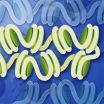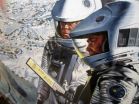(Press-News.org) Researchers show for the first time that a mammal begins to suckle its mother's milk through a learned response built on learning her unique combination of smells. When it is born, the newborn is exposed to the smell of its mother's amniotic fluid and the baby then responds to those smells to feed.
Prevailing thought has been that pheromones –chemicals that trigger an innate behaviour – drove the suckling response as an automatic behaviour. The new work determines that, in mice, the smells must be learned before the behaviour can occur.
Suckling is a critical step for survival in mammals, which are defined by giving birth to offspring that need to feed from their mother's milk. The newborn must begin to feed soon after birth or it will die. It is a crucial, defining behaviour in mammals and offers researchers an opportunity to investigate the biology of instinct.
Previous research into suckling has shown that European rabbit mothers use a pheromone to initiate suckling in their newborn babies. This led most scientists to think that all mammals were likely to use the same mechanism. Keen to discover the pheromone involved in other mammals, the team chose the mouse because they have a parenting style similar to that of humans, nurturing and caring for their young.
"We were expecting to find a pheromone controlling suckling in mice, but we found a completely different mechanism at work," says Dr Darren Logan, lead author of the study from the Wellcome Trust Sanger Institute. "We have shown for the first time that it is not a pheromone response in mice, but a learned response, founded on a mix of odours: the unique signature smell of the mother."
To discover the smells involved in initiating suckling, researchers introduced newborn mice delivered by Caesarean section to breasts that had been washed clean and then soaked in one of the fluids that a baby would first inhale at birth. These included amniotic fluid, the mother's saliva (from being licked clean), breast milk and urine. Only the breasts that smelt of the mother's amniotic fluid initiated suckling.
The team then tested for the presence of a pheromone in the amniotic fluid. They fed pregnant mice strong smelling foods, such as garlic, to change the signature odour of the mother. If a pheromone was involved, the garlic would have no effect on suckling. In fact only those mice that had previous exposure to the amniotic fluid with the strong smell from their mother were able to feed successfully, proving the signature odour must be learned.
"Our work shows us that there is no species-wide pheromone that makes newborn mice feed, but that the mouse pups are actually learning their mother's unique and variable mix of smells at birth," explains Associate Professor Lisa Stowers, senior author from The Scripps Research Institute. "So, although the suckling response may look like a pheromone-mediated behaviour, it is actually initiated through a fundamentally different process."
Supporting evidence for this conclusion comes from genetic research conducted by the team. They found that mice who lack a critical gene in the pheromone-detecting region of the nose, called the vomeronasal organ (VNO), were able to locate the mother's nipple and to suckle. In contrast newborn mice who lacked the ability to smell regular smells, detected in a region called the main olfactory epithelium (MOE) struggled with feeding.
"This is a neat study which shows the value of studying the development underlying an apparently 'innate' behavior." Dr Tristram Wyatt of the University of Oxford. "The surprising result is that mouse pups use the individual odours of the mother to find their first feed. It is a reminder of the way that evolution uses whatever works: there is more than one way to find the first milk meal. The rabbit has a pheromone in the milk, humans may have one around the nipple, and mice learn the individual odour of their mother. All three enable the vital task of getting the newborn to suckle."
Learning a signature odour may be a critical component of other innate behaviours in mammals. Because humans also form an intensive, nurturing bond with their babies, it suggests that genetic manipulation of the ability to smell in mice will be a useful way to research the neural pathways involved in human instinctive behaviour.
###
Notes to Editors
Publication Details
Darren W Logan, Lisa J Brunet, William R Webb, Tyler Cutforth, John Ngai, Lisa Stowers. (2012) 'Learned recognition of maternal signature odors mediates the first suckling episode in mice'
Published in Current Biology 4 October 2012: DOI: 10.1016/j.cub.2012.08.041
Funding
This work was supported by the NIH-NIDCD and the Skaggs Foundation, and Wellcome Trust grant.
Participating Centres
Department of Cell Biology, 2Center for Mass Spectrometry, The Scripps Research Institute, La Jolla, CA 92037, USA.
Wellcome Trust Sanger Institute, Hinxton, Cambridge, CB10 1SA, UK.
Department of Molecular and Cell Biology, University of California, Berkeley, Berkeley, CA 94720, USA.
Office of Research Development, University of California, Irvine, Irvine, CA 92697, USA
Selected Websites
The Scripps Research Institute is one of the world's largest independent, not-for-profit organizations focusing on research in the biomedical sciences. Over the past decades, Scripps Research has developed a lengthy track record of major contributions to science and health, including laying the foundation for new treatments for cancer, rheumatoid arthritis, hemophilia, and other diseases. The institute employs about 3,000 people on its campuses in La Jolla, CA, and Jupiter, FL, where its renowned scientists—including three Nobel laureates—work toward their next discoveries. The institute's graduate program, which awards Ph.D. degrees in biology and chemistry, ranks among the top ten of its kind in the nation.
www.scripps.edu
The Wellcome Trust Sanger Institute is one of the world's leading genome centres. Through its ability to conduct research at scale, it is able to engage in bold and long-term exploratory projects that are designed to influence and empower medical science globally. Institute research findings, generated through its own research programmes and through its leading role in international consortia, are being used to develop new diagnostics and treatments for human disease.
http://www.sanger.ac.uk
The Wellcome Trust is a global charitable foundation dedicated to achieving extraordinary improvements in human and animal health. We support the brightest minds in biomedical research and the medical humanities. Our breadth of support includes public engagement, education and the application of research to improve health. We are independent of both political and commercial interests.
http://www.wellcome.ac.uk
Contact details
Don Powell Media Manager
Wellcome Trust Sanger Institute
Hinxton, Cambridge, CB10 1SA, UK
Tel +44 (0)1223 496 928
Mobile +44 (0)7753 7753 97
Email press.office@sanger.ac.uk
End of Notes to Editors
Babies learn the smell of mum
Newborn mice use mum's unique odour, not a pheromone, to begin breastfeeding
2012-10-04
ELSE PRESS RELEASES FROM THIS DATE:
New function of a protein involved in colon cancer is identified
2012-10-04
Researchers from IMIM, Hospital del Mar Medical Research Institute, have succeeded in determining the function of a new variant of enzyme IKKalpha (IKKα) to activate some of the genes taking part in the tumor progressions of colorectal cancer. In the future, this fact will make it possible to design new drugs that inhibit this enzyme specifically and are less toxic for the remaining body cells, hence improving the treatment for this disease.
The study is the culmination of previous research by the IMIM Research Group on Stem Cells and Cancer that had proven the ...
Penn researchers create a universal map of vision in the human brain
2012-10-04
PHILADELPHIA - Nearly 100 years after a British neurologist first mapped the blind spots caused by missile wounds to the brains of soldiers, Perelman School of Medicine researchers at the University of Pennsylvania have perfected his map using modern-day technology. Their results create a map of vision in the brain based upon an individual's brain structure, even for people who cannot see. Their result can, among other things, guide efforts to restore vision using a neural prosthesis that stimulates the surface of the brain. The study appears in the latest issue of Current ...
Better battlefield triage, transport may raise severely wounded soldiers' survival rates
2012-10-04
CHICAGO—Wounded soldiers who sustained chest injuries in Operation Enduring Freedom (Afghanistan) and Operation Iraqi Freedom (Iraq) had higher mortality rates than soldiers
in Korea and Vietnam, according to a military trauma study presented at the 2012 American College of Surgeons Annual Clinical Congress. However, better battlefield triage and transport may have meant that severely wounded soldiers whom would have been considered killed in
action in previous conflicts are more likely to get sent to trauma centers in the United States sooner in their course of care, ...
Chewing ability linked to reduced dementia risk
2012-10-04
Can you bite into an apple? If so, you are more likely to maintain mental abilities, according to new research from Karolinska Institutet in Sweden.
The population is ageing, and the older we become the more likely it is that we risk deterioration of our cognitive functions, such as memory, decision-making and problem solving. Research indicates several possible contributors to these changes, with several studies demonstrating an association between not having teeth and loss of cognitive function and a higher risk of dementia.
One reason for this could be that few ...
No evidence for 30-nm chromatin fibers in the mouse genome
2012-10-04
HEIDELBERG, 4 October 2012 – Scientists in Canada and the United States have used three-dimensional imaging techniques to settle a long-standing debate about how DNA and structural proteins are packaged into chromatin fibres. The researchers, whose findings are published in EMBO reports, reveal that the mouse genome consists of 10-nm chromatin fibres but did not find evidence for the wider 30-nm fibres that were previously thought to be important components of the DNA architecture.
"DNA is an exceptionally long molecule that can reach several metres in length. This means ...
New gene test detects early mouth cancer risk
2012-10-04
Researchers from Queen Mary, University of London have developed a new gene test that can detect pre-cancerous cells in patients with benign-looking mouth lesions. The test could potentially allow at-risk patients to receive earlier treatment, significantly improving their chance of survival.
The study, published online in the International Journal of Cancer, showed that the quantitative Malignancy Index Diagnostic System (qMIDS) test had a cancer detection rate of 91-94 per cent when used on more than 350 head and neck tissue specimens from 299 patients in the UK and ...
Top executives' team spirit affects whole business
2012-10-04
Los Angeles, CA(04 October, 2012) Effective teamwork among an organization's top management makes employees happier and more productive, with positive benefits to the organization.
Despite an abundance of research on teamwork in the workplace, studies of how teamwork right at the top impacts employees lower down the food chain is surprisingly thin on the ground. Now researchers have surveyed business theory and put it to the test empirically, showing that top management's behaviour does trickle down. This new research is published by SAGE in the journal Human Relations.
Does ...
Olympic legacy: Tackling the 'East London Diabetes Belt' is a major challenge
2012-10-04
A study by Queen Mary, University of London researchers has shown the scale of the challenge facing those in charge of delivering the Olympic legacy. In three London boroughs they have found that, overall, as many as one in ten of the local population has a high risk of developing type 2 diabetes within the next ten years. In some areas close to the Stratford Olympic Park up to one in six adults are at high risk.
The study, published in the British Journal of General Practice [1], analysed half a million electronic records for all people without diabetes, aged between ...
Strathclyde take the lead in space research
2012-10-04
Academics at the University of Strathclyde in Glasgow are set to investigate the removal of space debris and deflection of asteroids – leading the first research-based training network of its kind in the world.
The 'Stardust' project will train the next generation of scientists, engineers and policy-makers with Strathclyde leading 14 partners across Europe in a new €4 million programme.
The European Commission-funded network will launch early next year and its pioneering research will have a significant impact on the future decisions of Europe on some of the most pressing ...
Science fiction is not put to good use in teaching
2012-10-04
A study at the University of Valencia ensures that science fiction, especially the cinema, is very popular amongst secondary school students and teachers see it as a good way of motivating interest in the sciences. However, out of the 31 textbooks analysed, only nine make some form of reference to science fiction cinema as a teaching resource.
"A current concern is that students are no longer studying science and engineering and this trend is more common amongst females. Science fiction can be useful in awaking the scientific vocation of younger students," as explained ...
LAST 30 PRESS RELEASES:
NTP-enhanced lattice oxygen activation in Ce-Co catalysts for low-temperature soot combustion
Synergistic interface engineering in Cu-Zn-Ce catalysts for efficient CO2 hydrogenation to methanol
COVID-19 leaves a lasting mark on the human brain
Scientists use ultrasound to soften and treat cancer tumors without damaging healthy tissue
Community swimming program for Black youth boosts skills, sense of belonging, study finds
Specific depressive symptoms in midlife linked to increased dementia risk
An ‘illuminating’ design sheds light on cholesterol
Who is more likely to get long COVID?
Study showcases resilience and rapid growth of “living rocks”
Naval Research Lab diver earns Office of Naval Research 2025 Sailor of the Year
New Mayo-led study establishes practical definition for rapidly progressive dementia
Fossil fuel industry’s “climate false solutions” reinforce its power and aggravate environmental injustice
Researchers reveal bias in a widely used measure of algorithm performance
Alcohol causes cancer. A study from IOCB Prague confirms damage to DNA and shows how cells defend against it
Hidden viruses in wastewater treatment may shape public health risks, study finds
Unlock the power of nature: how biomass can transform climate mitigation
Biochar reshapes hidden soil microbes that capture carbon dioxide in farmland
Reducing saturated fat intake shows mortality benefit, but only in high-risk individuals
Manta rays create mobile ecosystems, study finds
Study: Mixed results in using lipoic acid to treat progressive multiple sclerosis
Norbert Holtkamp appointed director of Fermi National Accelerator Laboratory
New agentic AI platform accelerates advanced optics design
Biologists discover neurons use physical signals — not electricity — to stabilize communication
Researchers discover that a hormone can access the brain by hitchhiking
University of Oklahoma researcher awarded funding to pursue AI-powered material design
Exploring how the visual system recovers following injury
Support for parents with infants at pediatric check-ups leads to better reading and math skills in elementary school
Kids’ behavioral health is a growing share of family health costs
Day & night: Cancer disrupts the brain’s natural rhythm
COVID-19 vaccination significantly reduces risk to pregnant women and baby
[Press-News.org] Babies learn the smell of mumNewborn mice use mum's unique odour, not a pheromone, to begin breastfeeding


